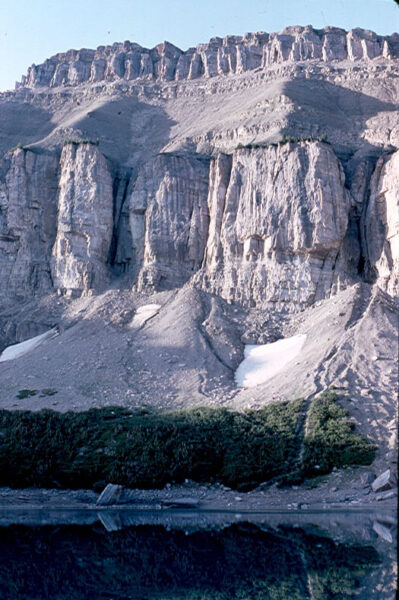Neidium bobmarshallensis
-
Category
-
Length Range60-79 µm
-
Width Range14.8-17.8 µm
-
Striae in 10 µm13-15
-
Reported AsNeidium kozlowi var. elliptica (Foged 1981, p. 135, plate XXVI, fig. 6)
?Neidium kozlowii (Metzeltin et al. 2009, p. 336, plate 102, figs. 2-7; not plate 103, figs. 7-11)
-
ContributorLoren Bahls - Apr 2013
-
ReviewerSarah Spaulding - Aug 2013
Identification
Description
Valves are lanceolate with broadly rounded and unprotracted or very weakly protracted apices. A longitudinal line is evident along each margin. The axial area is straight, about three times wider than the raphe, becoming somewhat wider near the central area. The central area is wide, rectangular in shape and crosses the valve diagonally. It is bordered by short faint striae along the valve margins. The raphe is lateral, becoming filiform at the proximal ends, which are hooked sharply in opposite directions. Striae are oriented diagonally across the valve face. Areolae number 20-24 in 10 µm.
Autecology
Besides three lakes in the Bob Marshall Wilderness of northwestern Montana, Neidium bobmarshallensis has been recorded from Logging Lake in nearby Glacier National Park. On the date the Logging Lake sample was collected, pH measured 7.78 and specific conductance measured 43. This species was also reported (as N. kozlowi var. elliptica) from a small pond in the Brooks Range of Alaska (Foged 1981).
-
Size Range, µm3
-
Motility
-
Attachment
-
Habitat
-
Colony
-
Waterbody
- Learn more about this
Original Description
Valves lanceolate with broadly rounded, very weakly protracted apices. Valve length 60–79 μm; valve width 14.8–17.8 μm. A longitudinal line evident along each margin. Axial area straight and narrow, flaring a bit near the central area. Central area wide, rectangular, oriented diagonally to the apical axis. Central area bordered by short faint striae along valve margins. Raphe lateral, becoming filiform at the proximal ends, which are hooked sharply in opposite directions. Striae oriented diagonally across the valve face, 13–15 in 10 μm. Areolae 20–24 in 10 μm.
-
AuthorBahls 2013
-
Length Range60-79 µm
-
Width14.8-17.8 µm
-
Striae in 10µm13-15
Citations & Links
Citations
Links
-
Index Nominum Algarum
Cite This Page
Bahls, L. (2013). Neidium bobmarshallensis. In Diatoms of North America. Retrieved November 21, 2024, from https://diatoms.org/species/neidium_bobmarshallensis
Responses
The 15 response plots show an environmental variable (x axis) against the relative abundance (y axis) of Neidium bobmarshallensis from all the stream reaches where it was present. Note that the relative abundance scale is the same on each plot. Explanation of each environmental variable and units are as follows:
ELEVATION = stream reach elevation (meters)
STRAHLER = distribution plot of the Strahler Stream Order
SLOPE = stream reach gradient (degrees)
W1_HALL = an index that is a measure of streamside (riparian) human activity that ranges from 0 - 10, with a value of 0 indicating of minimal disturbance to a value of 10 indicating severe disturbance.
PHSTVL = pH measured in a sealed syringe sample (pH units)
log_COND = log concentration of specific conductivity (µS/cm)
log_PTL = log concentration of total phosphorus (µg/L)
log_NO3 = log concentration of nitrate (µeq/L)
log_DOC = log concentration of dissolved organic carbon (mg/L)
log_SIO2 = log concentration of silicon (mg/L)
log_NA = log concentration of sodium (µeq/L)
log_HCO3 = log concentration of the bicarbonate ion (µeq/L)
EMBED = percent of the stream substrate that is embedded by sand and fine sediment
log_TURBIDITY = log of turbidity, a measure of cloudiness of water, in nephelometric turbidity units (NTU).
DISTOT = an index of total human disturbance in the watershed that ranges from 1 - 100, with a value of 0 indicating of minimal disturbance to a value of 100 indicating severe disturbance.

Neidium bobmarshallensis
- Valves lanceolate
- Central area diagonal
- Striae diagonal
Neidium bobmarshallensis has lanceolate valves, 14-18 µm wide. The central area is diagonal. Striae are also diagonal and number 13-15 in 10 µm. The proximal raphe ends are hooked in opposite directions.
 Diatoms of North America
Diatoms of North America






